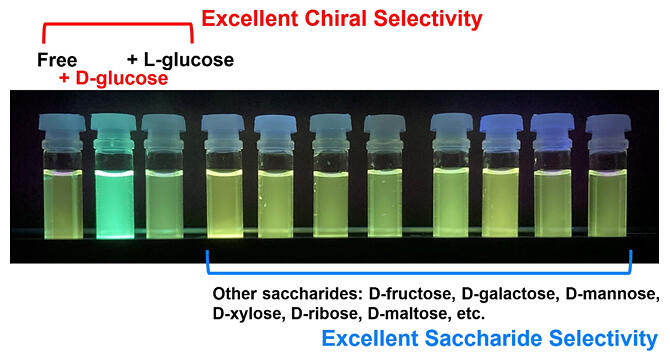A research group led by Professor Takashi Hayashita and Yota Suzuki (JSPS Research Fellow PD) of the Faculty of Science and Technology, Department of Materials and Life Sciences, Sophia University, in collaboration with Waseda University and the Chiba Institute of Technology, has achieved a highly sensitive and selective fluorescent-based recognition of glucose (D-glucose) in water using a supramolecular compound of cyclic oligosaccharides and simple fluorescent molecules.

Provided by Takashi Hayashita and Yota Suzuki (Sophia University)
Glucose (D-glucose) is widely present in the body as blood sugar, and tracking and managing its precise concentration is vital for the early detection and treatment of diabetes. However, since various other sugars coexist with D-glucose in the body, accurately measuring its concentration requires the development of a dedicated sensor. To address this need, the research group developed a supramolecular compound composed of multiple molecules and pseudo-diboronic acid moieties (a compound attracting attention as an essential backbone for next-generation blood glucose sensors), finding that it allows for highly selective fluorescent recognition of glucose (D-glucose). In particular, it can identify the D and L forms of glucose, which are extremely difficult to distinguish.
This simple supramolecular compound consisting of a fluorescent molecule and a cyclic oligosaccharide was shown to recognize D-glucose and exhibit a dramatic enhancement of light emission in water, demonstrating very high sensitivity, selectivity, and chiral selectivity for D-glucose.
Hayashita commented, "We plan to take advantage of its simple structure to add a variety of functionality in the future. For example, we are thinking of giving it the ability to recognize excess glucose and release drugs (much like the pancreas) or develop new luminescent materials that can distinguish D- and L-bodies with high sensitivity."
Journal Information
Publication: ACS Sensors
Title: Recognition of D-Glucose in Water with Excellent Sensitivity, Selectivity, and Chiral Selectivity Using γ-Cyclodextrin and Fluorescent Boronic Acid Inclusion Complexes Having a Pseudo-diboronic Acid Moiety
DOI: 10.1021/acssensors.2c02087
This article has been translated by JST with permission from The Science News Ltd. (https://sci-news.co.jp/). Unauthorized reproduction of the article and photographs is prohibited.




